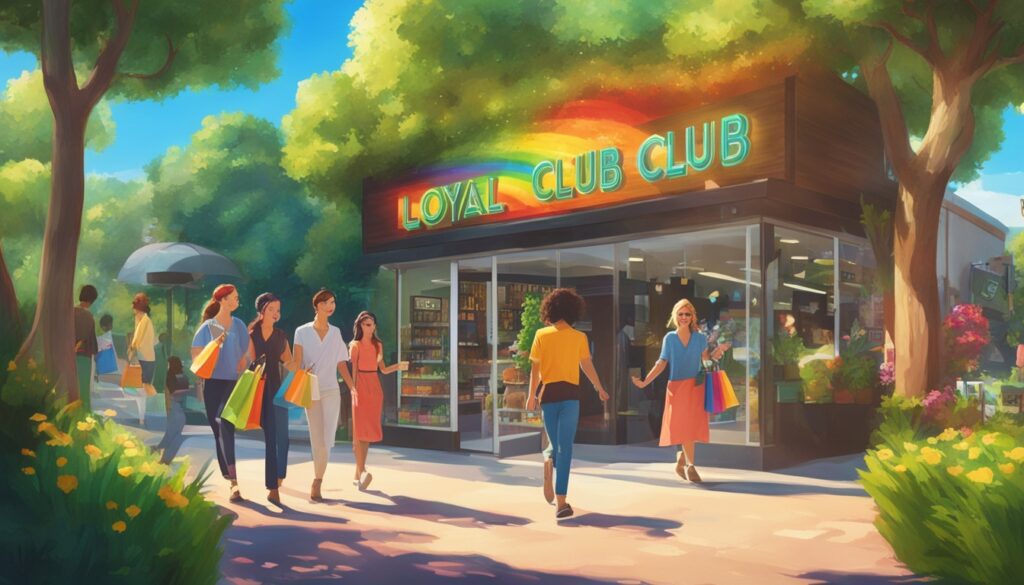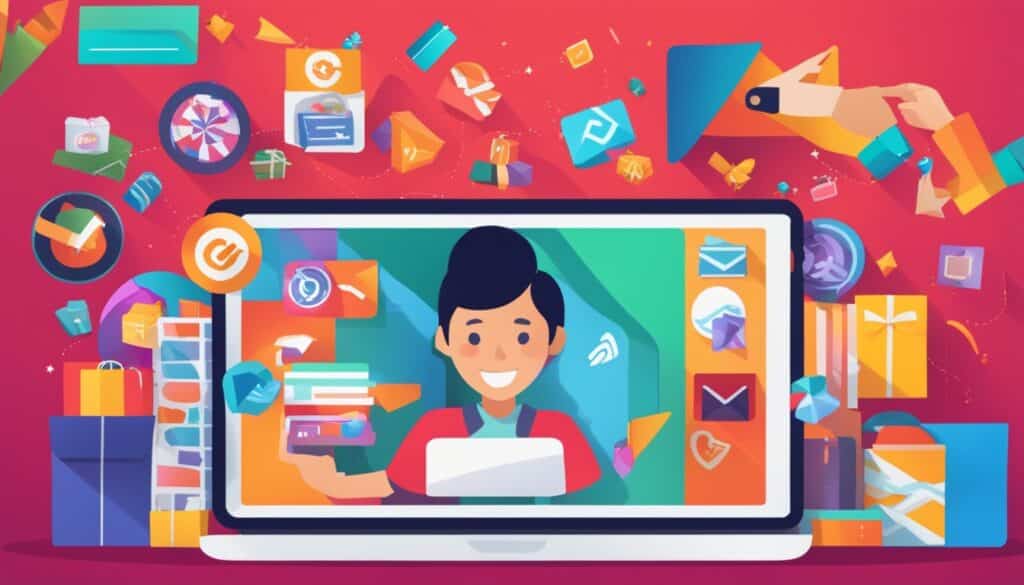Menu

Increasing customer retention by just 5% can boost profits from 25% to 95%. So, if you want to keep your business thriving, focus on attracting repeat customers. For this, having a strong online presence is vital.
Businesses that interact closely with customers build loyalty and establish stable income sources. They use online platforms to offer loyal customers special benefits, early product access, or discounts. In our digital world, enhancing customer loyalty is key to improving a brand’s reputation.
Offering valuable content and answering customer queries are vital for keeping customers. By listening to customers and using their feedback, businesses can strengthen their bond with them. This not only ensures customer loyalty but also makes them feel part of something bigger, enhancing their emotional connection with the brand.
Customer loyalty means that previous customers keep coming back. It’s vital for a business’s success, helping to keep income steady and encouraging growth. By using the right customer loyalty strategies, a business can improve customer interactions online and build lasting relationships. Let’s look at what customer loyalty means and how it boosts business success.
Customer loyalty happens when people are happy with what they bought or experienced. They trust and prefer one brand over others. For example, a huge 92% of Apple’s customers are loyal. This shows the power of building trust and offering great products and experiences.
Having loyal customers is great for a business. They not only buy more themselves but also recommend the brand to others. Remember, customers who come back spend 67% more than new ones. Also, keeping customers online is cheaper than finding new ones, by up to five times.
Loyal customers give business a big financial boost. Just a small 5% more customers coming back can increase profits a lot, between 25% to 95%. They also help by costing less to keep and by spending more – like e-commerce customers who spend double thus highlighting how loyalty returns through profit.
| Statistic | Economical Impact |
|---|---|
| Customer retention increase by 5% | Boosts profits by 25%-95% |
| A 2% retention increase | Equal impact as reducing operating costs by 10% |
| Repeat e-commerce customer spending | Double compared to new customers |
| New customers vs. Existing customers cost | New customers cost 5 times more |
Today, keeping online customers happy is a must for any business. They must use certain steps to make interaction better, train teams well, and show empathy to customers.
To keep customers, companies need to reply quickly and accurately. Most people think a fast first response is vital. Use live chat, FAQs, and easy contact methods. This lets customers get help fast and easily. Using personalisation makes the customers feel special and want to buy again. More than half of customers will share their personal details for a better experience.
Customer service teams need thorough training. They should know the products inside out. Soft skills like listening and clear talking are also key. Since most profits come from repeat buyers, the teams must listen well and be helpful. Regular training keeps them sharp, ready for any issue. Staff should know that customer satisfaction surveys are how happy clients are with the service.
Empathy is vital to keeping customers around. A negative experience might send almost half of customers to a rival. Making clients feel understood and important is crucial. A caring attitude, along with problem solving, turns complaints into happiness. More than two-thirds of buyers base their choices on company values, so being truly caring is a big deal for success.
| Statistic | Percent |
|---|---|
| Profits from repeat or returning customers | Up to 80% |
| Business owners prioritising customer retention | Only 32% |
| Importance of quick response to inquiries | 89% |
| Customers willing to switch after one bad experience | Nearly 50% |
| Impact of customer service on company growth | 64% |
| Consumers likely to purchase with personalised experiences | 80% |

Keeping customers happy online directly impacts profits and company growth. Training staff well and showing empathy in every interaction boosts customer satisfaction and loyalty.
A website is like a digital shop window. It shapes how people see customer service. It’s vital for fostering online customer relationships and boosting online customer retention. While many focus on gaining new customers, it’s cheaper to keep the old ones. Building relationships with existing customers costs less—about $7. However, getting new ones costs roughly $34.
First, a site should load fast. Users get irritated if they wait too long. This can make them leave.
The design must be smooth and simple. An easy-to-use site makes buying a breeze. Use SEO tricks, like the right keywords. They help attract people. Also, add social login tools to make it easy for users to sign in. LoginRadius, for example, lets people sign up using different social platforms. This boosts user experience and keeps them coming back.
Try to create a community on your site. Share personalised content and ask for feedback. It makes users feel valued. And more than half say they would buy again after a personal shopping experience. Don’t forget about loyalty programmes. They can increase repeat purchases by six times.
| Metrics | Importance |
|---|---|
| Number of Returning Visitors | Indicates customer satisfaction and ongoing interest |
| Frequency of Visits | Reflects user engagement and content value |
| Conversion Rates | Measures the effectiveness of the user journey |
In the end, good website usability is all about building strong relationships with your customers. This keeps them coming back. It’s shown to increase business revenue by up to 40%. So, it pays off to focus on this area.
In today’s digital world, it’s vital to offer exclusive deals and incentives. This helps keep customers engaged and build loyalty online. By offering deals that match your customers’ needs, you improve customer loyalty and boost your sales. This article looks at ways to keep customers returning to your business.

Referral bonuses are a great way to gain new customers. By rewarding your existing customers for bringing in new ones, you create a cycle of growth. This method not only keeps your current customers involved but also attracts new ones through trusted referrals.
Offering early access to new products helps build an online customer base. This special access makes loyal customers feel valued, improving their bond with your brand. It also encourages new customers, leading to more sales and interactions.
Special prices and personalised discounts can greatly enhance customer loyalty. Timing these promotions with what your customers prefer helps keep them happy. By using email and social media wisely, you make customers feel special, increasing repeat sales.
| Strategy | Impact on Customer Retention | Revenue Growth |
|---|---|---|
| Referral Bonuses | 30% Increase | 70% of Sales Revenue |
| Early Access to Products | 80% in Cosmetics and Restaurants | 25% Increase in Satisfaction |
| Promotional Pricing | 40% Higher Customer Return Rate | 10-20% More Spend |
By using these strategies, businesses can grow a committed customer base online. This leads to significant and steady business growth.
Staying in touch with customers is key for any business. It helps build long-lasting loyalty. Companies use social media, emails, and custom content to connect with people.
Businesses love social media for its quick links to customers. They post updates and special content to keep people involved. A strong connection through social media means customers might spend more with a brand they trust.
Using social media well can bring in new customers and keep them coming back.
Emails are still a top way to talk to customers. Sending personalised emails keeps people interested. They feel special with recommendations and unique deals.
Creating targeted emails helps businesses grow steadily over time. Studies show this can boost sales by up to 85%.
Personalised newsletters and content make customers curious. Great content can make people buy more. Companies use data to know what their customers like, making their messages hit home.
Businesses that focus on keeping customers happy do much better. They lose fewer customers and outshine their rivals. Making content personal builds trust and lets companies share what matters with their customers.
It’s key to make your business easy to find. This helps bring customers back and build good online connections. To do this, show clear contact details, use chatbots, and have an easy-to-use online store. These steps make the customer’s journey smooth.
No one should struggle to contact your business. You need to clearly show your email, phone numbers, and social media. This stops customer irritation and makes them come back more. They can easily find the information they need.

Chatbots are great at keeping online customers happy. They give quick answers and help with buying. Having them on your site can make customers more satisfied. It means they might choose to come back again.
Having a website anyone can use is a must. It should be easy to find, especially for those with disabilities. Use alt text on images, keep content clear, and make navigation simple. This way, you welcome more people and keep them coming back.
| Key Aspects | Benefits |
|---|---|
| Accessible Contact Information | Prevents customer frustration and enhances repeat business. |
| Chatbot Technology | Provides instant support, improving user experience. |
| Website Accessibility | Complies with legal standards, attracts a wider audience. |
To keep customers loyal online, focus on what they need. A good plan means understanding their needs. It also means using their feedback well.
Making the customer the focus is key. This means making their experience special. It includes fast service and an easy-to-use website. These things keep customers coming back, which is great for business.
Knowing what customers want is important for keeping them. Do market research and talk to customers. This way, you can make your products and how you sell them better.
Feedback is like finding gold. It helps make things better. Making changes from feedback shows customers you care. This boosts loyalty and can help launch new products successfully.
A strong customer focus, built on understanding and using feedback, makes for lasting customer relationships online. This leads to customers staying with your brand and your business growing. It’s the key to long-term success.
Using personalisation in digital experiences boosts customer loyalty and sales. Businesses use customer data to create unique experiences. This makes people feel valued and understood.

Product recommendations are a key part of personalisation. Companies look at what you buy and the pages you visit. They suggest products tailored just for you. For example, Amazon boosts its sales by suggesting personalised items.
This not only makes shopping better but can also increase total sales for grocery stores by 1-2%. It can boost other retailers’ sales even more.
Targeted marketing is crucial for personalisation. It allows businesses to talk to certain customer groups. This can lead to more sales. Sephora uses personalised messages to keep its members interested. They have 25 million, and 80% of their sales come from these efforts.
Marketing and sales costs can drop by 10-20% with effective personalisation. Plus, the return on investment can be three times more than with standard promotions.
Personalisation really impacts customer engagement and loyalty. It can increase customer satisfaction by 20%, and sales by 10-15%. It also improves employee satisfaction by 20-30%. So, investing in personalisation is key to keeping customers happy in the long run.
To make a customer loyalty programme work, you need to know what makes online shoppers come back. Then, you create a reward system that keeps them happy. With the right plan, you can boost how often they shop with you and how much they like your brand.
Reward systems are key in customer loyalty programmes. They might offer points or different membership levels for your customers. Studies show that 68% of folks who shop a lot would sign up for something that offers real, clear benefits. A smartly designed system makes each buy seem more valuable, which often means they buy again and again.
Keeping track of how loyal your customers are is a must. Using smart tools, you can see how they use the loyalty programme. This info helps you reward them at the right time, making them feel special. It also stops them from looking elsewhere because they feel you don’t appreciate them enough.
| Key Metrics | Impact |
|---|---|
| Participation Rate | Measures engagement and programme effectiveness |
| Redemption Rate | Indicates usefulness and attractiveness of rewards |
| Customer Lifetime Value | Assesses overall benefit derived from loyal clients |
| Retention Rate | Tracks percentage of repeat customers |
Today, businesses need to be socially responsible to keep customers happy online. Companies that match their values with those of their customers build strong emotional ties. This bond boosts loyalty.

CSR work involves things like giving to charity and being eco-friendly. When brands do this, 88% of shoppers are more likely to buy from them. Plus, they could increase the loyalty of customers by 306%.
For instance, the pizza place &pizza is famous for helping out in the community. By working with local causes, they’ve won over customers.
Helping out and being part of the community also win hearts online. &pizza gave pizzas to those fighting COVID-19, which made customers even more loyal. Today, 9 out of 10 young people would change brands to support a good cause.
Companies that give back do better financially and in how much they’re worth. A strong purpose can increase sales by 20% and value by 20%.
Many leaders see CSR as key, with 64% of CEOs saying it’s important. It’s also a big deal for protecting the company’s image, with 76% agreeing. Not doing CSR can even make 83% of staff want to leave their jobs. Showing care boosts employee happiness and makes them stay.
CSR changes happy customers into fans who spread the word. This helps companies grow and keeps people loyal for the long haul.
Feedback is key in digital customer engagement and keeping a loyal customer base. It helps you know what customers like and don’t like. This insight helps you meet their needs better.
It’s crucial for businesses to find and fix their customers’ problems. 73% of people expect companies to understand what they need. This makes gathering feedback through surveys, reviews, and talking to customers very important.
With 98% of people checking reviews for local businesses, it’s clear feedback is invaluable. It helps companies learn what their customers truly think and what they need.
Acting on customer feedback shows a brand cares about its customers. According to research, personalised service turns more than half of customers into repeat buyers. This underlines the importance of using feedback to improve services.
Moreover, 83% of shoppers are more loyal to companies that solve their complaints. This highlights the power of swift and effective feedback responses in building loyalty.
Integrating feedback boosts digital customer engagement and trust. When customers see their feedback leading to real changes, they feel valued. This approach helps in building loyal customers online.
Handling customer complaints well is crucial for keeping online customers happy. It’s about turning problems into chances to do better. This builds lasting satisfaction and loyalty.
Start by really listening when customers share their concerns. Let them know you understand and are sorry. Next, act fast to fix the problem.
Teach your team to be empathetic and ask the right questions. This helps them find solutions that fit each customer’s needs. Good team communication ensures problems are solved quickly, keeping customers happy.
See complaints as chances to get better. Use negative feedback to improve. This shows you care and builds trust and loyalty.
Keeping track of complaints helps spot ongoing issues. Surveys like Customer Satisfaction (CSAT) can help find specific problems.
Also, use customer loyalty programmes to keep customers coming back. Offering rewards for loyalty and solving complaints can make a big difference.

To show how good complaint handling can boost customer loyalty programmes:
| Complaint Aspect | Effective Resolution Technique | Positive Outcome |
|---|---|---|
| Active Listening | Showing empathy, acknowledging concerns | Increased customer trust |
| Timely Response | Quick action to resolve issue | Improved customer satisfaction |
| Empathetic Approach | Sincerely apologising and offering solutions | Enhanced customer loyalty |
| Follow-up | Ensuring issue resolution and customer satisfaction post-resolution | Additional feedback for business improvement |
In short, managing complaints well is key to keeping customers happy online. By changing bad experiences into good ones, you can build strong, lasting bonds with your customers.
To build a strong online customer base, it’s key to put the customer first all the way. Doing so ensures that most customers come back because they love the service. It also helps avoid losing over half of them if they aren’t happy. Offering great service, loyalty rewards, and personal offers can make a big difference.
Keeping the customers we already have not only saves money but also makes a lot of money. If we keep just 5% more of our customers, profits can grow by a lot. Loyal customers spend more and are likely to come back often. They have a good chance of visiting us again, especially after their first buy.
Making our customers feel special by offering personalised deals is very effective. Most people, 86% to be exact, buy more when the offers are tailored to them. We can do this through various ways, like through multiple platforms or special deals. When we show we care, over half of our customers are happy to tell us more about themselves.
When we excel in customer service and provide an easy website, everyone wins. Businesses and their customers both see the benefits. Good service, easy shopping, and knowing our customers well keep them coming back. It’s a win-win situation that helps businesses survive and grow.
Customer loyalty means people who bought from you before are likely to buy again. It’s important because it boosts revenue and sales, and it costs less than getting new customers.
Having loyal customers brings in steady money and makes your company known in a good way. It keeps people buying from you and costs less to keep them happy than to get new ones.
Loyal customers keep money coming in, which helps reduce your costs and price your products better. This leads to more profit and a stronger position in the market.
To make customers like talking to your team, make sure they are friendly, know their stuff, and quick to help. Being empathetic is key to making a good connection. Plus, being patient, clear, and fast in your replies can turn a one-time buy into a regular customer.
Your team should know the products well and understand what the customer wants. Soft skills like being kind, patient, and talking well are important. They should also be great at solving problems to keep customers happy.
Empathy is big in customer service. It helps in really understanding and fixing customer problems. This makes them like you more and want to do business with you again.
A website that’s easy to use, loads fast, and is simple to find your way around keeps customers around. It makes buying from you smooth and welcomes them to come back.
By rewarding referrals, you get your current customers to bring you new ones. This grows your customer base and makes your clients feel appreciated.
Offering early access makes your loyal customers feel special. This feeling makes them stick with your brand, coming back more often.
Promotions draw in new customers and keep the old ones coming back. Discounts and special offers show them they’re getting a good deal, making them stay loyal.
Social media is great for staying in touch with your customers. Post things that interest them, talk to them quickly, and make them a part of the conversation. This keeps your brand on their minds.
Emails are a strong tool to keep people interested. Making the emails personal and relevant lets customers know what’s new and helps them remember to visit your website.
By sending out newsletters that feel personal, you show customers you understand them. This makes them trust you more and want to keep shopping with you.
Having easy ways to get in touch helps customers feel looked after. Fast and clear replies build trust and keep them coming back.
Chatbots quickly answer customer queries, anytime, day or night. They handle basic questions, freeing up staff for trickier ones. This makes customers happier with the service.
To make sure more people can use your website, add descriptions for images and organise the content well. Features that help those with disabilities show you care about everyone as a customer.
A good strategy focuses on what customers need. Listening to them and making changes shows you’re dedicated to their satisfaction. This way, they’re more likely to stay with you.
Knowing what customers want and giving it to them makes them happy. Happy customers come back, staying with you for the long term.
Listening to feedback helps fix problems and make things better. Doing this shows you care and makes customers more loyal.
Personal recommendations make shopping feel tailored to the customer. They’re more likely to be satisfied and want to buy from you again.
Targeted campaigns speak to what customers like, which keeps them interested. By personalising your message, they feel more connected to your brand.
Your programme should offer rewards that people find valuable. Whether it’s points or special membership levels, this keeps them coming back.
Watching how customers interact with you, like how often they buy and what they do in loyalty schemes, helps. It lets you give them the right rewards, keeping them interested.
CSR activities show what your brand cares about and gives back. This can make customers like you more, connecting them emotionally to your brand.
Being active in the community shows you care, which makes customers feel good about choosing you. This caring feeling makes them more loyal.
Finding and fixing what upsets your customers makes their experience better. Happy customers are more likely to come back, staying loyal.
Using feedback shows you listen and want to make things better for your customers. This care makes them more satisfied and loyal.
Listen well, say sorry genuinely, and fix the problem quickly. This turns negatives into positives, showing you care about their experience and keeping them close.
Complaints are chances to learn and grow. By seeing and fixing what’s wrong, you make customers happier. This care reinforces their loyalty and protects your brand’s image.